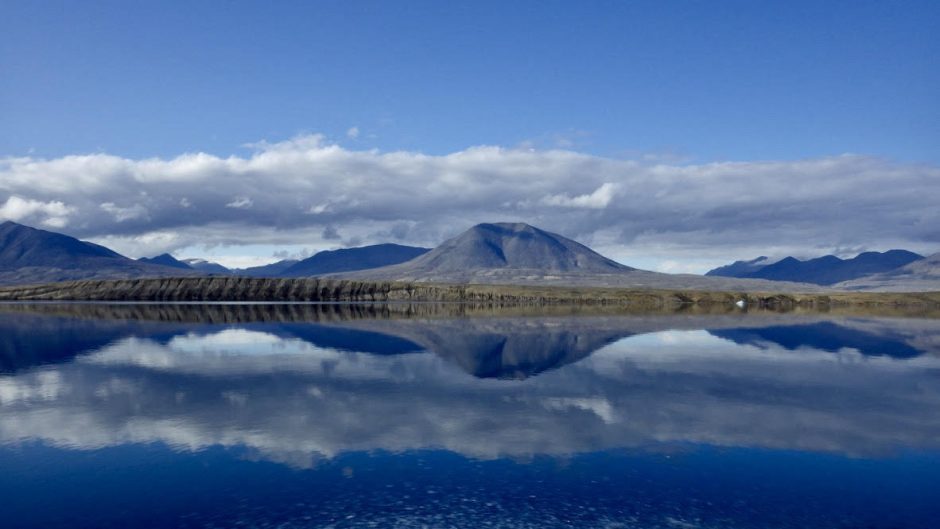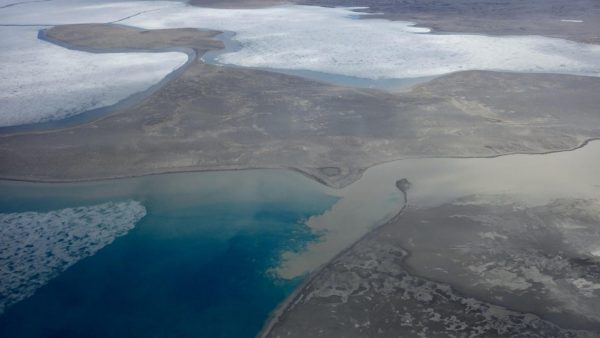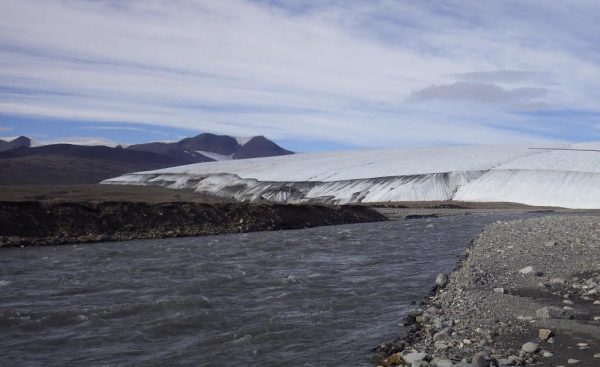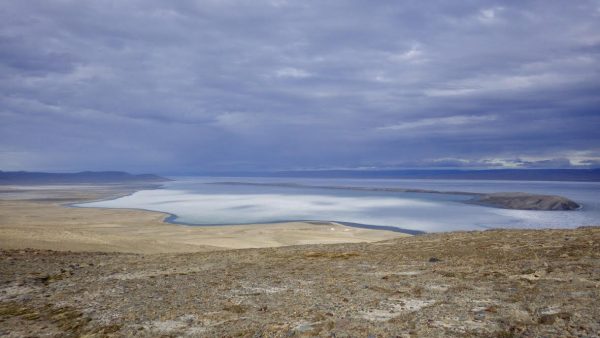Climate Change Rapidly Warming World’s Largest High Arctic Lake

Lake Hazen at the end of July, after the lake ice has melted. (Credit: Kyra St. Pierre, via communication)
One of the more difficult aspects of educating people about climate change is how remote its consequences can sound. However, as the pace of warming accelerates, this is less true—and recent research results from an interdisciplinary team focused on the largest High Arctic lake in the world reveal just how quickly a warming climate can change an ecosystem.
The changing face of Lake Hazen
Lake Hazen on Canada’s Ellesmere Island is undergoing a massive series of changes—all because of a temperature increase of a single degree. This one degree set into a motion the disruption of the ecosystem on a scale that is alarming to researchers. Glaciologist and University of Alberta professor Martin Sharp and University of Alberta Vanier Scholar PhD student Kyra St. Pierre corresponded with EM about the recent paper and what inspired the research.
“Lake Hazen is the only true Great Lake in the Arctic, and the only very large lake in the most northerly regions of Canada,” explains Sharp. “The idea of Polar Amplification of anthropogenic climate change suggested this region might be experiencing significant and rapid changes. Previous work in the area had focused primarily on small lakes. The goal was to explore how all aspects of the environmental system around the lake were changing and how these changes might be impacting the biggest lake in the area.”
Now the lake is experiencing a chain of events that has been put into motion by the rise in temperature—a stark reminder that even a change that sounds small might have serious consequences.
“There are two major sets of changes that seem to be driving everything else,” details Sharp. “The first is that increasing summer melt from glaciers is resulting in large increases in the amount of water going into the lake. Since this water is glacier-derived, it is also transporting large amounts of fine-grained rock flour. The second is that the extent of lake ice on the lake in summer has decreased significantly. Consequences of this are increasing amounts of sediment input to the lake, which makes the water column turbid, altering the light environment in the lake, and also results in accelerated deposition of mineral sediment on the lake floor, at least in regions where glacier-fed streams enter the lake. This would potentially be stressful for bottom-living organisms.”
The team monitored and measured the amount of glacial meltwater going into the lake using a model and comparing predicted inflow to actual outflow amounts.
“The meltwater inputs to the lake were actually computed with a numerical model of glacier melt, but the outflow from the lake is gauged, so it was possible to compare the calculated inflow with the measured outflow (the increased inflow raises the lake level, so outflow increases as a result),” adds Sharp.
The glacier mass balance model the team used was driven by measured/modeled inputs of snowfall and air temperature. This allowed the team to compute the yearly accumulation of snow on the glaciers, along with the annual removal of snow/ice mass by surface melting. Model calculations were validated against satellite-derived estimates of the temperature of the glacier surface and the surface albedo—the fraction of incoming solar radiation that is reflected back to space from the glacier surface—which tells you how much radiative energy is available to heat up and melt the surface.
“Knowing how this changes over time lets you determine how changes in surface characteristics influence melt rates over time,” remarks Sharp. “Glacier surface albedo depends upon the snow/ice grain size, how wet the snow surface is, whether there is dust accumulating on the surface, whether microbial populations are colonizing the snow/ice surfaces—all of which create a darker surface that absorbs more solar energy and melts more rapidly. The temperature of the glacier surface helps us track what fraction of the glacier surface area was melting at any point in any given summer, and how the melting area changed over each summer season. This allowed us to identify what were likely to be low and high melt years and compare these with estimates of water flow into and out of the lake.”

The murky, brown glacial meltwaters entering the clear blue waters of the lake. (Credit: Kyra St. Pierre, via communication)
The team approached the amount of sediment, the contents of the sediment, and the rate of mineral sediment deposition on the lake bottom in other ways.
“Sediment fluxes to the bottom of the lake were determined by dating sediment cores collected at the deepest location in the lake (~267 m),” St. Pierre describes. “The cores were dated using lead-210 and cesium-137 activities. Chemical profiles of the sediments were determined using a number of different techniques, depending on the analyte of interest, but always on freeze-dried sediments. Fluxes of, for example, mercury, carbon, and organic contaminants, were then determined by comparing the concentration profiles against the sediment core age models. Sediment loads in the meltwater-fed rivers weren’t specifically examined in this study.”
The lake’s water quality and chemistry changed significantly with the warmer weather—something the team thought might be mitigated by the large size of the lake.
“Since glaciers act as stores of both nutrients and contaminants deposited atmospherically, sometimes after long-range transport from more southerly locales, with increasing glacial melt in the watershed we’ve seen an increase in fluxes of both nutrients (nitrogen, phosphorus, carbon) and contaminants (as evidenced by mercury and organochlorine pesticides and related compounds in this study specifically) to the lake,” remarks St. Pierre. “Because these compounds are largely sediment-bound, they are transported and deposited to the depths of the lake. These heavily sediment-laden inflows generate turbidity currents which transport turbid, oxygenated surface waters right to the bottom of the lake. Whereas oxygenation of bottom waters were likely historically rare, the lake now completely mixes in the summer, at least partially in consequence of the greater volume of glacial meltwaters.”
Although these changes suggest that it might be wise to monitor the lake’s water quality and chemistry moving forward, it’s not clear how that will be possible.
“Exactly how or whether the lake water quality itself will be monitored moving forwards is unknown,” states St. Pierre. “Given the remote location, access to the site and logistics once there are particularly challenging and costly for researchers.”
However, St. Pierre points out that Lake Hazen is located within Quttinirpaaq National Park, under the jurisdiction of Parks Canada. A number of ongoing monitoring programs within the watershed do exist, including continuous gauging of the Ruggles River outflow, annual collections of Arctic char for contaminant analyses, and annual water quality surveys of a limited number of glacial inflows to the lake.
Big changes in a short period of time
Since 1981, Arctic char in Lake Hazen have been monitored via a collaboration between Parks Canada and Environment and Climate Change Canada. The team in this research used samples from this collaboration.
“In recent years, the physiological condition of the char has declined, though the exact causes are unknown,” reports St. Pierre. “Char are visual predators, and increased glacial inputs to the lake have resulted in more turbid conditions along the lake edge. These shallow edge waters are important feeding habitat for the char and murky waters there may prevent the char from seeing their prey (chironomids and other char).”
Adding to this problem are the now ice-free summers which have become the norm in the area.

Gilman Glacier and the meltwater river, which eventually enters Lake Hazen. (Credit: Kyra St. Pierre, via communication)
“Between 1985 and 1995, the lake didn’t go ice-free 4 times; from 1996-2005, that number declined to 2 times; and since 2005, there has only been 1 year (2009) where the lake retained any ice cover through the summer,” St. Pierre explains. “This is combined with the fact that the ice-free season on the lake has become longer over time.”
Ice-free conditions on the lake is critical to the ecosystem because the presence or absence of ice-cover determines how much light penetrates into the lake, and, by extension, how much primary productivity exists. The consequence that has already been noted is algal blooms—all the way in the Arctic.
“In the future, longer ice-free seasons may also result in increased heat absorption by surface waters with the consequent biological effects of warmer, ice-free waters,” details St. Pierre. “Following ice-out in the summer, we tend to see a local shift in the weather around Lake Hazen. During the ice-covered season in the summer, the lake area is typically beautifully warm (for the High Arctic), with almost uninterrupted clear, sunny days, but following ice-out, the winds tend to pick up and cloud cover increases locally. Conditions from that point on become much more unpredictable. Of course at least part of this shift may be the result of reduced nearby sea ice extent, but Lake Hazen is certainly large enough that it can modulate the nearby climate. Open waters on the lake could certainly lengthen this period of unsettled conditions.”
When the team discusses how these findings have changed the outlook for this region, they point out two main points to contemplate.
“I think there are two issues to consider: (i) Is this change permanent (or the start of something even bigger, or (ii) will conditions revert back to how they were before this event,” remarks Sharp. “My guess is there could be even more to come if the climate continues to warm—unless we reach the point where the glaciers shrink sufficiently so that their water input starts to decrease, but we’re likely a ways off that happening.”
Quicker transformation points toward a future filled with rapid shifts
One of the most notable aspects of this research is the fact that despite the size of the lake, it reacted so strongly and rapidly to a single degree of warming. This was a surprise to the team, and likely for the scientific community as a whole.
“Probably because the changes observed were bigger and more rapid than anyone had anticipated,” states Sharp. “There is really no precedent in the historical record for what has happened recently—at least within the period for which direct observations exist. It may also be that previous work had not been as holistic as the work done in this study, so the interdependencies of and interactions between different physical, chemical and biological processes had not really been thought through in detail.”
These changes at Lake Hazen speak to the need for a big-picture perspective, and a move away from studying subsystems in silos, and instead adopting a holistic, systemic approach to the questions of climate change.

Lake Hazen in early July, before ice melt. (Credit: Kyra St. Pierre, via communication)
“All the subcomponents of the environmental system in the Lake Hazen area are subjected to essentially the same climate forcing, and they are also connected together by a common climate and climate history, and by flows of water, sediment and dissolved solutes (and likely also legacy contaminants stored in glaciers and permafrost),” Sharp describes. “Therefore, the effects of changes in upstream parts of the system (like glaciers) are readily transmitted to downstream components, producing a cascade of changes that are best understood if studied in a way that recognizes the important connectivities within the system as a whole.”
Moving forward, Sharp points out that for Hazen specifically, it would be valuable to extend the time period of the study. “Especially if the (summer) climate continues to warm, as we may not yet have seen the full extent of what is possible in this system,” adds Sharp. “I suspect permafrost, in particular, may change more in future than it has done during the period of this study.”
St. Pierre emphasizes the connectivity between the watershed components.
“We are just beginning to see evidence of permafrost slumping in the region, which is one of the characteristic features of more southerly locations in the Arctic (e.g., along the Peel Plateau in the Northwest Territories), but has yet to be that important in High Arctic environments,” explains St. Pierre. “This could have important consequences for hydrology and biogeochemistry in the watershed, especially when combined with continued glacial melt.”
One of the greatest triumphs of this work, aside from revealing a much more rapid series of changes than expected, was the team’s interdisciplinary nature, which allowed them to successfully combine a variety of techniques.
“I think that one of the interesting aspects of this work is the combination of techniques from many different fields coming together to show overwhelming evidence of watershed-scale perturbations in the High Arctic,” states St. Pierre. “Several datasets used in the work were derived using remote sensing products (glacial surface mass balance, surface temperatures, lake ice records, lake surface temperatures), and these were able to match quite nicely to the records collected in-situ (outflow discharge, sediment core archives, fish samples, soil temperatures).”
There’s no way to know exactly what will happen to Lake Hazen as our climate continues to warm, but the team is poised to find out.
Top image: Lake Hazen at the end of July, after the lake ice has melted. (Credit: Kyra St. Pierre, via communication)




Pingback: Climate Change Rapidly Warming World's Largest High Arctic Lake - Lake Scientist